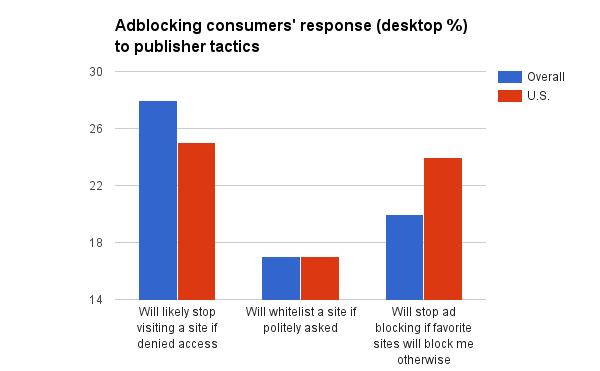To some, ad blocking is a mortal threat to publishers. To others, it is an overblown fad. More evidence is mounting that ad blocking is more nuisance than existential threat today, but that could easily change.
A new survey of users found that only 41 percent of those surveyed were aware of ad blocking. But among those who are aware of it, 80 percent block ads on desktop and 46 percent do so on smartphones, suggesting it’s just awareness that’s holding back higher ad blocking adoption. And among those blocking, roughly half said they planned to ad block as long as they can.
The survey is part of a report, “Decoding The Adblocking Consumer,” by Midia Reseach, a London-based media research and consulting firm. It was done in March and is based on 3,600 respondents age 16 and up in the U.S., U.K., Brazil, Australia, France and Sweden.
The survey of ad blocking consumers also found that only 17 percent of desktop users would whitelist a site if politely requested to do so. But fully 28 percent said they’d stop visiting a site if they’re denied access — a move that could potentially cost the publisher an important audience segment. (Respondents were asked to select sentences that applied to them, so numbers don’t add up to 100 percent.)
A bright side may be that the hard-line tactics can be effective with a site’s core fans. When asked if they’d otherwise lose access to their favorite sites, 20 percent of desktop users said they’d turn off their ad blockers rather than lose access. While other research has found that ad blocking rates are higher on tech and gaming sites, here the type of site mattered less than how loyal people were to the site.
Ad position: web_incontent_pos1
The revelations come amid fresh figures showing a sharp rise in ad blocking by mobile users. The survey also has bad news for people who might have hoped that ad blocking is a fad. Ad blocking awareness isn’t overwhelming —
Still, while the polite message may be less effective, it’s less likely to alienate readers who are an important part of the audience.
At The Atlantic, for example, readers who use ad blockers consume a lot more page views than the average visitor. “Part of the challenge is, the ad blocking audience is big fans,” said Kim Lau, svp, digital and head of business development there.
Ad position: web_incontent_pos2

“Whether one should or should not use the outright ban tactics will vary based on the size and characteristics of publishers’ audiences, their share of ad-blocking users, the loyalty of its audience as well as their ability to successfully deploy alternative revenue streams,” said Karol Severin, a mobile content analyst at Midia Research.
In the case of Slate, it’s been running a polite message asking ad blocker users to support Slate by buying a membership. David Stern, director of product development there, said that the conversion rate is high enough that Slate ends up recovering about 5 percent of the ad revenue it loses as a result of ad blocking.
“We’re not willing to pursue the scorched-earth approach,” Stern said. “By asking nicely we’ve had some reasonable results that make us optimistic about the prospects of recovering some revenue without turning huge swaths of readers off.”
More in Media

NewFronts Briefing: Samsung, Condé Nast, Roku focus presentations on new ad formats and category-specific inventory
Day two of IAB’s NewFronts featured presentations from Samsung, Condé Nast and Roku, highlighting new partnerships, ad formats and inventory, as well as new AI capabilities.

The Athletic to raise ad prices as it paces to hit 3 million newsletter subscribers
The New York Times’ sports site The Athletic is about to hit 3 million total newsletter subscribers. It plans to raise ad prices as as a result of this nearly 20% year over year increase.

NewFronts Briefing: Google, Vizio and news publishers pitch marketers with new ad offerings and range of content categories
Day one of the 2024 IAB NewFronts featured presentations from Google and Vizio, as well as a spotlight on news publishers.
Ad position: web_bfu






